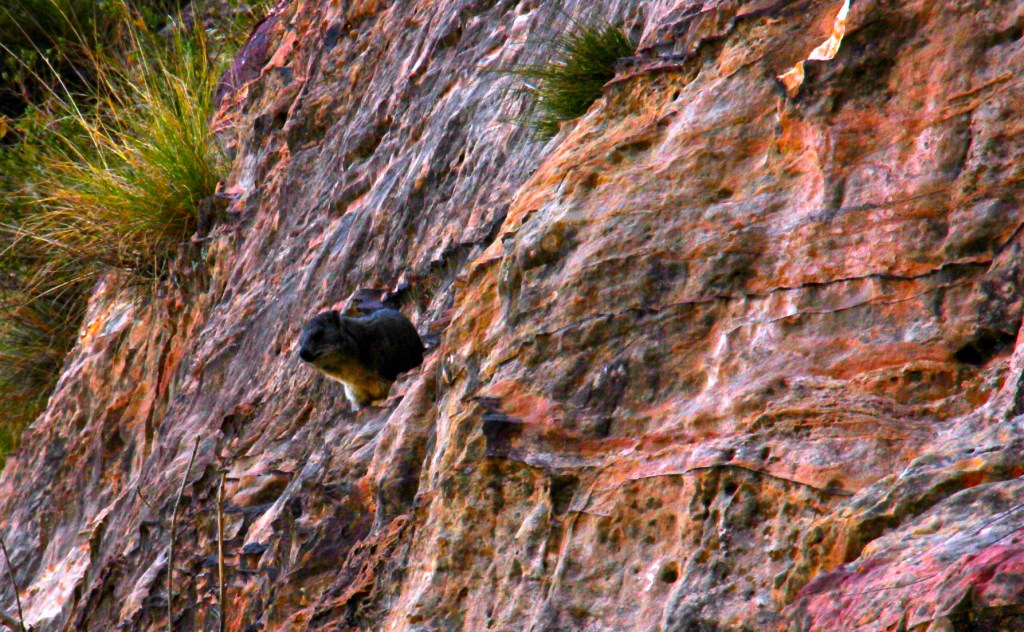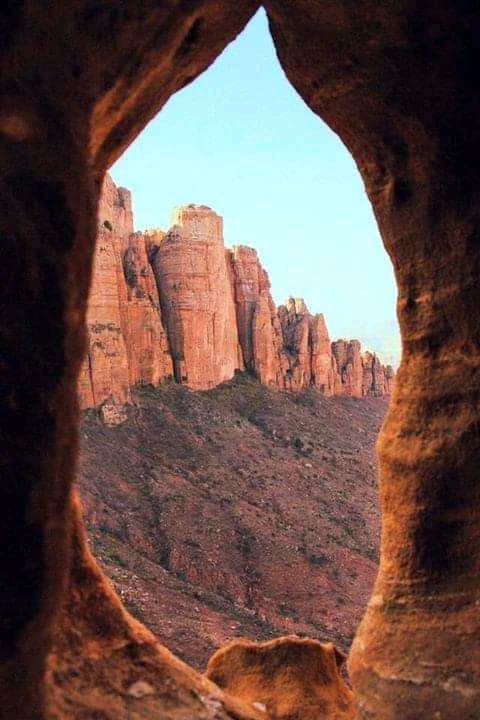
The beautiful Tigray region of Ethiopia
Table of Contents
Leaving Aksum for Tigray rock-cut churches

Tigray looks both timeless and atmospheric
Abuna Yemata, the world’s most inaccessible church

View from Abuna Yemata, the most inaccessible Tigray rock-cut churches
The “climb of faith” – to do or not to do

Hiking up to Maryam Korkor
Finding peace or death by free fall

The vast plains of Tigray
Tigray rock-cut churches travel guide
Where are the Tigray rock-cut churches?
Tigray rock-cut churches are located in Ethiopia’s mountainous north-eastern region. These are set between the cities of Aksum and Mekelle and are not easy to reach except by private car or organized tour. The best base is the town of Hawzen.
Tigray rock-cut church groups
There are more than 100 churches in the Tigray region and these are clustered into 5 main groups. The Gheralta group of churches is most visited and these are located nearest to Hawzen. The Gheralta group of churches are also the quickest and easiest to access. The three most impressive ones, namely Abuna Yemata, Maryam Korkor, and Daniel Korkor are located here.

A visitor at Wukro Churkos, one of Tigray rock-cut churches
Tigray rock-cut churches itinerary
This itinerary includes both easy to access and nearly inaccessible churches. Either do both if you have time and a sense of adventure or choose your section.
Day 1
- Abraha We Atsbeha – Start early from Mekelle and head towards Wukro. Stop at Abraha We Atsbeha, the church of the twin kings. It is accessible by a short flight of steps, has beautiful murals, and sweeping views of the Gheralta region. The entrance fee is 250 Birr. Tips are expected by the priest and the guides who happen to latch on. The recommended place for an overnight stay is Korkor Lodge.
Day 2
- Abuna Yemata (Abuna Yemata Guh) – The monolithic church set atop a sheer rock pinnacle is a short drive away from Korkor Lodge. Start early to avoid the blazing noon sun. The first part of the climb is like a steep hike. Take it easy since Tigray is at an altitude of 2000m and above and you may get breathless. The second part requires clambering up the cliff face. Safety ropes that were previously used by the local guides were prohibited at the time of my visit in 2019. The steep rock wall has only handgrips and natural holes for footholds. Being barefoot is mandatory since it is holy ground. After clambering on top of a big boulder in the middle of the two pinnacles, the final stretch includes a dash along a narrow ledge to get to the entrance of the church. This is more scary than dangerous and you don’t want to look down the 250m drop. Return to Korkor Lodge after the hike and take the rest of the day off.
Day 3
- Maryam Korkor and Daniel Korkor (stop at Maryam Papaseit) – Start early for Maryam Papaseit church. Just an hour hike through the valley, it is an atmospheric semi-monolithic church located under a mountain ledge. The main sanctuary is hewn from the rock and the interiors have some well-preserved murals, which the priest can show by candlelight. Tipping is expected. Leave Maryam Korkor for the afternoon. It is on top of the mountain directly in front of Korkor Lodge. The ascent is a steep and strenuous 1,5-hour hike that sometimes includes clambering over rocks. The views are breathtaking. Maryam Korkor’s frescoes are faded. Its interior, however, has beautiful architectural features. Only the church’s old priest and an old nun live up there and they rarely descend. According to the custom, upon their death, they will be buried in the walls of the church, just like some of their predecessors. Daniel Korkor is located a few minutes away from Maryam Korkor. It overlooks the valley and is accessed via a ledge along a dizzying precipice. Daniel Korkor is very atmospheric since only a tiny door serves as the sole source of light inside the church.
These Tigray rock-cut churches are the main attractions in the area around Korkor Lodge. If you have more time on your hands, you can explore the other groups of churches as well.

Wukro Churkos
The easily accessible Tigray rock-cut churches
This part of the post is inspired by The Hot Flashpacker In her post, she has listed down the easily accessible Tigray rock-cut churches as the ones “for fat and old people” (in her guide’s words). Most of the churches mentioned here are accessible for both men and women, and for people with physical capabilities. These monuments fall en route Aksum to Mekelle.
- Mikael Alem Adi Kesho – This church is in a cluster of three Ethiopian stone churches near Teka Tesfai and involves a 100-foot climb up a single sandstone monolith rock. Entrance fee – Entry is 150 Birr
- Mikael Milhaizengi – Also located in the Teka Tesfai cluster of Ethiopian carved churches, this church is reached by a few minute hike up a hill. Best known for the unique circular dome ceiling, the priest may open the door to the holy place and show you the pages of a 1500-year-old bible for a tip. A 4×4 to get to this church, or one needs to hike over a mile from Mikael Alem Adi Kesho. A guide is recommended. Entrance fee – 150 Birr
- Wukro Churkos – This church is on the northeastern outskirts of Wukro and is the most accessible one. Located on mostly flat ground, this rectangular church resembles a free-standing monument, but in fact, has been carved from solid rock. Entrance fee – 150 Birr
- Abraha We Atsbeha – This church is a 45-minute drive from the main highway northwest of Wukro, followed by a 5-minute walk up about 100 steps. It has the loveliest murals. Entrance fee – 200 Birr

One of the frescoes
Tigray rock-cut churches visiting tips
- Remove your shoes before entering all the Tigray rock-cut churches in Ethiopia.
Don’t expect all the churches to be open. Sometimes the priest may not be in his office and you might not be able to visit or may have to wait for entry. - Each church has its entry fee of 150 to 200 Birr. Keep the receipt so they don’t ask for you to pay the entrance fee again.
Usually, the priest will expect and may even ask you for a tip.
Almost every Ethiopian antiquated church comes with additional people looking for money – from kids trying to sell you fossils and rocks, boys trying to be your guide, or old men wanting a tip to watch your shoes. Be firm and say “no” if the hassle gets too much.
The stony mountains of Tigray in northern Ethiopia
The tour to Abuna Yemata, Daniel Korkor, and Maryam Korkor with a stop at Wukro Churkos and 2N/3D in Danakil Depression cost me 700 Euros. It was an all-inclusive small group tour of six people and included accommodations, all meals, transfers, and guiding services. I went with Ethio Travel and Tours. Although there were some slight discrepancies with what we were promised and what we received, I was very much pleased with their services.

Marmot peeping at me on my hike to Maryam Korkor

A priest sitting near Maryam Korkor

Tigray panorama






Follow the rest of the Ethiopia series here
- 20 PHOTOS THAT WILL WANT TO MAKE YOU VISIT ETHIOPIA
- ETHIOPIA TRIP TIPS
- MY ADDIS ABABA MEMORIES
- PHOTO ESSAY OF ADDIS MERCATO
- ADDIS ABABA TO JINKA: AN ETHIOPIAN ROAD TRIP
- OMO VALLEY, THE HUMAN ZOO OF ETHIOPIA
- THE LOWER OMO VALLEY IN ETHIOPIA
- REAL LIFE PHOTOS OF OMO VALLEY TRIBES
- OMO VALLEY TRAVEL GUIDE AND TIPS
- MY LAZY, RELAXING AKSUM DAYS
RESPONSIBLE TRAVELING-BECAUSE I CARE

